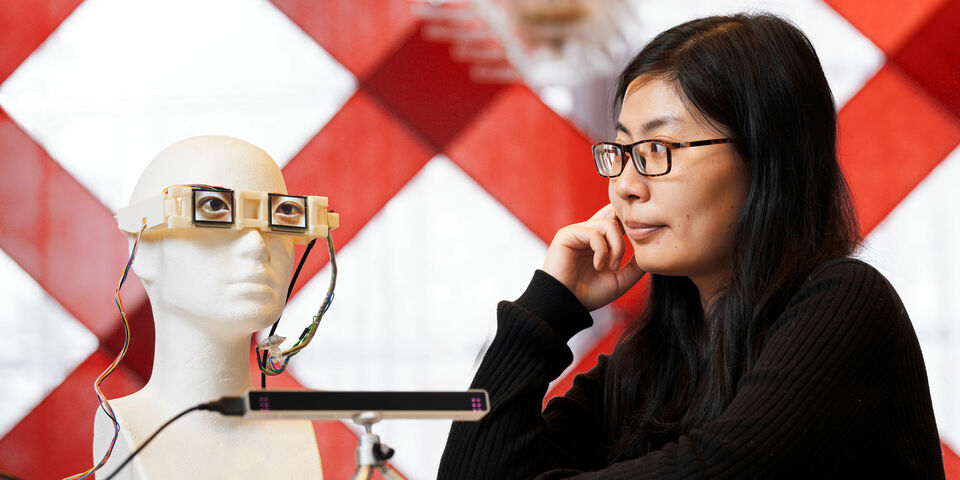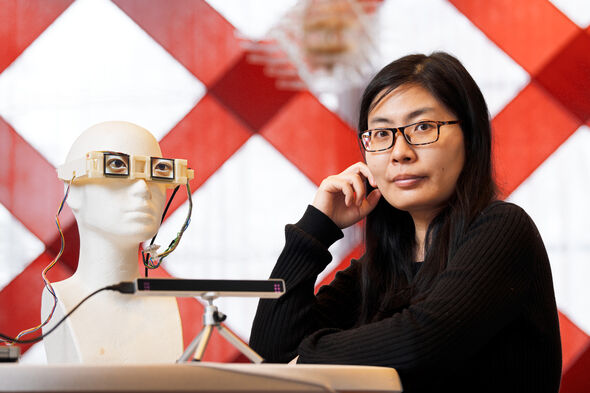Home Stretch | Improving communication for the blind
Face-to-face communication between the sighted and those with little or no sight often runs into difficulties. A person with impaired sight may not know when the sighted person is looking at him or her and receives little feedback. Shi Qiu, who gained her doctorate from the Department of Industrial Design on January 16th, has worked to improve this social interaction. She and other researchers designed a prototype of special spectacles and a wristband able to give feedback during a conversation.
According to Shi Qiu, little research has been done on simulating a blind person's gaze based on the eye tracking system. The aim of her research was to simulate the gaze of a blind person and to improve face-to-face communication between a blind person and a sighted person. She took a two-track approach. On the one hand she aimed to help the blind person to perceive the sighted person's gaze. In addition, she hoped to enable the blind person to simulate the appropriate gaze response.
Subtle signals
To achieve this, she carried out four studies during her doctoral study. “I interviewed twenty people in China,” Qiu tells us. “It made more sense for me to conduct the interviews in my home country; I can explain everything better in my mother tongue and it was easier to persuade people to take part.” Those twenty persons were blind or visually impaired. The tentative conclusion: these test subjects had difficulty picking up subtle signals -such as gaze and smile- during conversations.
Afterwards Qiu set to work with thirty test subjects with a view to giving them physical feedback. She designed the tactile band; a headband intended to ensure that the blind or partially sighted person receives feedback – in the form of a vibration – when the sighted person gazes at him or her. Although the quantitative results showed no clear effect, various participants indicated that they could concentrate better on their interlocutors. Not everyone felt comfortable wearing the band, however, Shi Qiu explains.
Next, forty participants were able to test the prototype of the E-gaze glasses, as Shi Qiu calls the spectacles her research team designed. Integral to the glasses is a system that tracks the eye movements of the interlocutor. The blind person wears these spectacles and uses the display that simulates 'eye contact'; in other words the glasses give the appearance of gazing at the interlocutor and of looking away. When the blind person starts talking, the E-gaze goes into 'look away' mode and when he or she stops talking, the mode switches to looking directly at the sighted person, signaling the turn for the sighted person. When the sighted person stares at the E-gaze, it switches to ‘look away’ mode to ensure the stare doesn't last too long.
Vibrate
Qiu eventually devised an improved system, whereby the blind person wears both the E-gaze glasses and an interactive wristband. The blind person feels the wristband vibrate when his or her interlocutor is gazing directly at him or her.
Qiu is keen to point out that the research is still in its infancy and sees plenty of opportunities for making improvements. “We still need to look at cultural differences. In Eastern culture, for example, people spend less time looking directly at each other than they do in Western culture. Another point is that you can generate feedback from sources other than just the eyes. It should also be possible to register a smile, for example. And suppose multiple persons are gazing at you at the same time? Moreover, we could design a wireless system.” Qiu hopes that she herself can take this research to the next level, but for the time being she is heading for Yangzhou, the city where she grew up.
She got a lot of help from her team members; her supervisors were Prof. Matthias Rauterberg and dr. Jun Hu and she collaborated closely with Siti Aisyah binti Anas and dr. Hirotaka Osawa.



Discussion